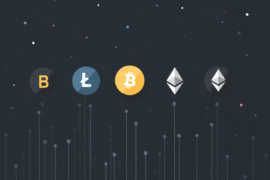This article may contain references to products or services from one or more of our advertisers or partners. We may receive compensation when you click on links to those products or services. Nonetheless, our opinions are our own.
The information presented in this article is accurate to the best of our knowledge at the time of publication. However, information is subject to change, and no guarantees are made about the continued accuracy or completeness of this content after its publication date.
The idea of a “strike price” is very important for anyone who wants to get into the fast-paced world of options trading. The strike price is more than just a number; it’s the set price at which an option can be exercised to buy or sell an underlying asset. It’s an essential benchmark that has a direct effect on an option’s value, potential profit, and risk profile. Knowing how to choose and use strike prices wisely is not just helpful; it’s absolutely necessary for making smart investment choices and confidently navigating the tricky world of options trading.
- Strike Price in Options Trading
- The Role of Strike Price in Your Investment Strategy
- How to Choose the Right Strike Price for Your Options
- Common Mistakes to Avoid with Strike Prices
- Leveraging Strike Price for Maximum Profit Potential
- Building Confidence in Your Options Trading Decision-Making
- The Relationship Between Strike Price and the Underlying Security
- Moneyness: The Three Types of Strike Prices
- Strike Price and Option Delta
- Conclusion
- Frequently Asked Questions
- What is a strike price?
- How does the strike price affect options trading?
- Why is it significant to choose the right strike price?
- Can you explain the relationship between strike price and time value?
- Are there any strategies related to choosing a strike price?
- What should beginners know about strike prices?
- Recommended Reads
Strike Price in Options Trading
When diving into options trading, understanding the concept of strike price is crucial. The strike price is the predetermined price at which you can buy or sell an underlying asset when exercising your option. Think of it as a critical milestone in your trading journey; it defines your potential profit and loss scenarios. For example, if you hold a call option with a strike price of $50 and the underlying asset rises to $70, this creates an opportunity for profit. Conversely, if the asset dips below the strike price, the option might expire worthless, emphasizing the importance of selecting the right strike price.
It’s beneficial to consider a few factors when evaluating strike price options:
Market conditions: Analyze current trends and market forecasts to determine an optimal strike price.
Time frame: The expiration date of your options affects how aggressively you should price the strike.
Risk tolerance: Your comfort with risk may influence whether you choose an in-the-money, at-the-money, or out-of-the-money option.
| Option Type | Strike Price Relation | Pros | Cons |
|---|---|---|---|
| In-the-Money | The current price is above the strike price (for call options) | Higher intrinsic value, better for exercising | More expensive premiums |
| At-the-Money | The current price is equal to the strike price | Balance of risk and reward | Lower intrinsic value, less room for profit |
| Out-of-the-Money | The current price is below the strike price (for call options) | Lower premiums, potential for high reward | No intrinsic value, risk of losing entire investment |
By carefully considering these aspects and how they relate to the strike price, you can position yourself to make more informed investment decisions.
The Role of Strike Price in Your Investment Strategy
Think of the strike price as important for making decisions about your investments when you trade options. The strike price is the set price at which you can buy or sell the underlying asset. It is a benchmark that can have a big effect on your choices. You can make sure your options fit with your financial goals and the way you see the market by choosing the right strike price. Here’s what to consider:
Risk vs. reward: Higher strike prices typically mean a lower premium for call options but can yield higher returns if the asset’s price increases. Lower strike prices come with higher premiums but offer a safer play if you anticipate modest price movements.
Market trends: Analyze current market conditions. A bullish market may encourage you to opt for a higher strike price, while a bearish outlook might steer you toward a lower one.
Time value: The closer an option is to its expiration date, the less time value it has. Selecting the right strike price can make a significant difference in how time decay affects your option’s profitability.
| Strike Price | Call Option Premium | Potential Profit Scenario |
|---|---|---|
| $50 | $3.00 | Price rises to $60 |
| $55 | $2.00 | Price rises to $60 |
| $60 | $1.00 | Price rises to $60 |
Incorporating the strike price into your strategy ensures you are not just investing—you’re investing wisely, with clear objectives and informed decisions guiding your financial journey.
How to Choose the Right Strike Price for Your Options
Choosing the right strike price is crucial for your options trading success. The strike price, or exercise price, is essentially the point at which you can buy or sell the underlying asset, and it plays a significant role in determining your potential profit and risk. Here are some key factors to consider:
Market outlook: Consider whether you anticipate the asset’s price will rise, fall, or remain stable. Opt for a strike price closer to the current price if you have a bullish outlook and want to increase your chances of being in the money.
Time until expiration: The more time you have until expiration, the greater the likelihood the underlying asset will hit your strike price. Evaluate the time horizon of your investment to make a more informed decision.
Volatility: In a highly volatile market, you might prefer a strike price farther from the current price to capture bigger price swings. In a stable market, a strike price closer to the current price may be more suitable.
| Strike Price | Market View | Risk Level |
|---|---|---|
| At-the-Money (ATM) | Neutral | Moderate |
| In-the-Money (ITM) | Optimistic | Lower risk |
| Out-of-the-Money (OTM) | Highly bullish | Higher risk |
Ultimately, the right strike price will align with your risk tolerance and market outlook, making it essential to evaluate all these factors to enhance your trading strategy effectively.
Common Mistakes to Avoid with Strike Prices
When diving into options trading, it’s easy to stumble into certain traps regarding strike prices. One of the most common pitfalls is ignoring the relationship between strike prices and the underlying asset’s price. For example, if you’re purchasing a call option, make sure that the strike price is realistic about the current market value. Choosing a strike price that’s too high may lead to a false sense of security, while selecting one that’s too low can diminish your potential profits.
Another mistake to steer clear of is failing to consider timing. Not all strike prices are created equal over time. Be mindful of expirations and their impact on volatility. As options approach expiration, their pricing can become more sensitive to changes in the underlying asset’s price.
| Strike Price Relation | Market Condition | Implication |
|---|---|---|
| Out-of-the-Money | Bearish Market | Higher risk, lower potential reward |
| At-the-Money | Volatile Market | Balanced risk and reward |
| In-the-Money | Bullish Market | Higher likelihood of profit |
Lastly, don’t underestimate the importance of conducting thorough research on implied volatility. Strike prices work best when aligned with your market analysis, not just gut feelings. Ignoring this element can lead to missed opportunities or unnecessary losses.
Voted "Best Overall Budgeting App" by Forbes and WSJ
Monarch Money helps you budget, track spending, set goals, and plan your financial future—all in one app.
Get 50% OFF your first year with code MONARCHVIP
Leveraging Strike Price for Maximum Profit Potential
The strike price is essential in options trading, as it is the predetermined price at which the underlying asset can be bought or sold when the option is exercised. This price influences the potential return on your investment and shapes your overall strategy. When selecting options, consider how the strike price relates to the current market price:
In-the-Money (ITM): Options with a strike price favorable compared to the current market price, providing intrinsic value.
At-the-Money (ATM): Options where the strike price is close to the market price, maximizing volatility potential.
Out-of-the-Money (OTM): Options with a less favorable strike price that require the asset to move significantly to become profitable.
Choosing the right strike price can significantly enhance your profit potential. For instance, if you believe a stock is poised for a rally, selecting a lower strike price (ITM) could ensure more substantial profits as the stock rises. Conversely, if you aim for higher returns with a speculative play, an OTM option might offer greater leverage, albeit with higher risks. Balancing the trade-off between risk and reward is essential. Tracking market trends and conducting thorough research can aid in making informed decisions.
Building Confidence in Your Options Trading Decision-Making
When you’re navigating the world of options trading, knowing the strike price is important for making informed decisions. Feeling confident in your trading moves comes down to knowing how each strike price can impact your options strategy. The strike price is the predetermined price at which you can buy (call option) or sell (put option) the underlying asset. This knowledge can help you evaluate potential profits and losses, thereby increasing your confidence in your decisions.
Consider these aspects when assessing strike prices:
In-the-money: This occurs when the current price of the underlying asset is above the strike price for call options or below it for put options. Trading in-the-money options typically has a higher intrinsic value and can provide a greater sense of security.
Out-of-the-money: A call option is out-of-the-money if the current price is below the strike price, and a put option is out-of-the-money if the current price is above it. These options can be cheaper but carry more risk and uncertainty.
At-the-money: When the underlying asset’s current price is the same as the strike price, you’re at the money. This scenario often leads to the most volatility, which can be both a challenge and an opportunity.
| Position | Call Option | Put Option |
|---|---|---|
| In-the-Money | Current price > Strike price | Current price < Strike price |
| Out-of-the-Money | Current price < Strike price | Current price > Strike price |
| At-the-Money | Current price = Strike price | Current price = Strike price |
Being well-informed about the nuances of strike prices will empower you to make choices that align with your financial goals and risk appetite.
The Relationship Between Strike Price and the Underlying Security
The relationship between the strike price and the underlying security is a crucial aspect of options trading. Understanding how the asset’s price relates to the strike price can significantly impact your trading decisions. When the asset price is above the strike price for call options or below it for put options, they are considered in the money. In-the-money options have higher intrinsic value and offer a sense of security due to their favorable position. Conversely, if the current price is below the strike price for a call option or above it for a put option, they are out-of-the-money.
Moneyness: The Three Types of Strike Prices
In options trading, moneyness refers to the relationship between the strike price and the current market price of the underlying asset. There are three main classifications based on this relationship:
In-the-Money (ITM): This is when the current market price is favorable for option exercise. For call options, it’s when the market price is higher than the strike price; for put options, it’s when the market price is lower than the strike price.
At-the-Money (ATM): At-the-money strike prices occur when the asset’s price is very close to the option’s strike price. This situation reflects uncertainty in the market regarding the future movement of the underlying security.
Out-of-the-Money (OTM): Out-of-the-money options are those where exercising the option would not be profitable at the current market price. They have no intrinsic value and rely solely on extrinsic factors for profitability.
Choosing the right strike price involves understanding your market outlook, risk tolerance, and investment strategy.
Strike Price and Option Delta
The strike price plays an important role in determining the option delta, which measures the sensitivity of an option’s price to changes in the underlying asset’s price. In-the-money options tend to have a higher delta, meaning their value changes more significantly with movements in the underlying asset. Out-of-the-money options have lower deltas, indicating less sensitivity to price changes. Options traders who want to control risk and optimize profits must comprehend the connection between strike price and option delta.
Conclusion
The “strike price” is the most important thing in options trading because it determines how much money an option could make or lose and how risky it is overall. To be successful, you must fully understand this idea, from its basic definition to how to choose the right strike based on market conditions, time frames, and your own risk tolerance. Traders can make much better decisions by knowing the differences between in-the-money, at-the-money, and out-of-the-money options and carefully avoiding common mistakes. Finally, a deep understanding of the strike price gives traders more confidence, helps them align their strategies with their financial goals, and gives them more insight and control as they navigate the ever-changing world of options trading.
Frequently Asked Questions
What is a strike price?
The strike price is the predetermined price at which an option can be exercised. For call options, it’s the price at which you can buy the underlying asset, while for put options, it’s the price at which you can sell it. It plays a crucial role in determining the option’s value and potential profitability.
How does the strike price affect options trading?
The strike price directly influences whether an option is “in the money,” “at the money,” or “out of the money.” Options that are in the money have intrinsic value, which can lead to higher premiums. Traders carefully choose the strike price based on their market predictions and risk tolerance.
Why is it significant to choose the right strike price?
Choosing the right strike price is vital for maximizing potential profits and minimizing risk. A strike price that aligns with your market outlook can lead to successful trades, while a poorly chosen strike price can result in losses. It’s essential to analyze market trends and your trading strategy before making a decision.
Can you explain the relationship between strike price and time value?
The time value of an option is influenced by the strike price, as it reflects the potential for the underlying asset’s price to move before expiration. Generally, options that are closer to being in the money carry a higher time value. As expiration approaches, the time value diminishes, making the strike price even more crucial in calculating potential gains.
Yes, several options trading strategies involve selecting different strike prices. For instance, some traders use straddles or strangles that include both call and put options with varying strike prices to capitalize on volatility. Others may utilize vertical spreads to limit risk and leverage potential profit by choosing multiple strike prices.
What should beginners know about strike prices?
Beginners should understand that the strike price is a fundamental concept in options trading that affects potential profits and risks. Newcomers need to educate themselves on different strike price strategies, practice with simulated trading, and develop a clear trading plan that considers their risk tolerance and market expectations.

Reviewed and edited by Albert Fang.
See a typo or want to suggest an edit/revision to the content? Use the contact us form to provide feedback.
At FangWallet, we value editorial integrity and open collaboration in curating quality content for readers to enjoy. Much appreciated for the assist.
Did you like our article and find it insightful? We encourage sharing the article link with family and friends to benefit as well - better yet, sharing on social media. Thank you for the support! 🍉
Article Title: Strike Price: The Key to Mastering Options Trading
https://fangwallet.com/2025/06/11/strike-price/The FangWallet Promise
FangWallet is an editorially independent resource - founded on breaking down challenging financial concepts for anyone to understand since 2014. While we adhere to editorial integrity, note that this post may contain references to products from our partners.
The FangWallet promise is always to have your best interest in mind and be transparent and honest about the financial picture.
Become an Insider

Subscribe to get a free daily budget planner printable to help get your money on track!
Make passive money the right way. No spam.
Editorial Disclaimer: The editorial content on this page is not provided by any of the companies mentioned. The opinions expressed here are the author's alone.
The content of this website is for informational purposes only and does not represent investment advice, or an offer or solicitation to buy or sell any security, investment, or product. Investors are encouraged to do their own due diligence, and, if necessary, consult professional advising before making any investment decisions. Investing involves a high degree of risk, and financial losses may occur including the potential loss of principal.
Source Citation References:
+ Inspo
There are no additional citations or references to note for this article at this time.











































